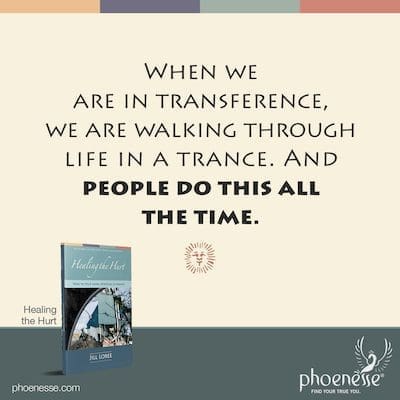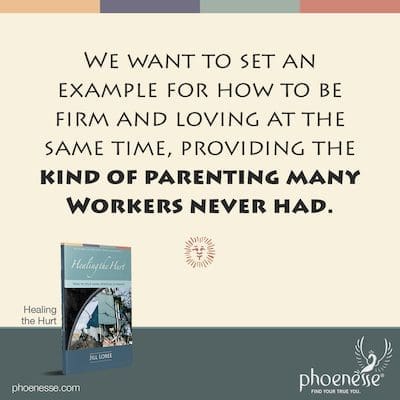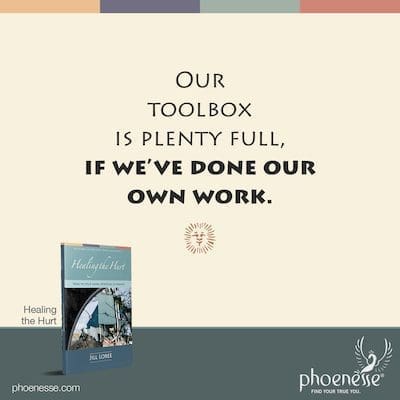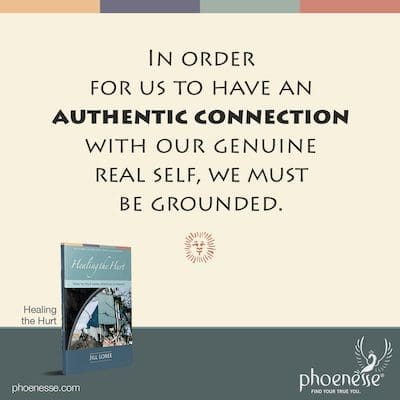- What about Transference?
- What is Helper Consciousness?
- The Importance of Grounding
- Working with Groups
The stance we hold with the Worker is going to evolve over the course of our working relationship, as the Worker matures. Starting out, the Worker presents mostly their demanding, self-centered inner child. They move to realizing the cruelty of their highly charged Lower Self. Finally, they grow out of their transference with us, moving into the fullness of their real self and living in reality.
All the while, we are mirroring good boundaries and self-care. We are also calling them to take more and more responsibility for their inner distortions and the life they have created.
It’s important to recognize that this is a journey. And sometimes it’s a slow one. Seldom is it a linear path straight to freedom.

Along the way, we need to always encourage the Worker to not skip steps. Likewise, we need to watch any tendency in ourselves to want the Worker to be anywhere other than where they are. Their work will unfold and develop as the Worker grows. And we need to continually monitor where they are in terms of their progress.
We want to hold a space of acceptance for the Worker to be 100% exactly where they are. This is key for moving forward to where they want to be, even as we may need to hold their feet to the fire when they drift into apathy or resistance.
What about Transference?
Perhaps the oddest thing about transference is that the word itself doesn’t share roots with the word “trance.” Because when we are in transference, we are walking through life in a trance. And people do this all the time. Transference, as well as countertransference, is something that can be learned about from many, many sources today. (Read more in Knowing When to Refer Out.) But as a Helper, we will know of this phenomenon from our own work with our Helper, as well as from the countless ways and places we’ve uncovered it appearing throughout our own lives.

As the Guide describes it, it is an illusion that takes place with spouses and children, with friends and colleagues and bosses, and of course with Helpers. In its most basic form, it is the overlaying of the reaction we had to our parents onto other people without realizing we are doing this. It is part of the recreation of childhood hurts.
We don’t see the person standing in front of us for who they are. We just see them as someone who will act towards us the way our parents did. This illusion causes us to behave in a way that forces the other person to actually meet our expectations. This wouldn’t have happened, though, if we hadn’t set the whole scene up the way we did. All this happens unconsciously, of course, and hence the trance.
When we are in transference, we are not in reality.
A critical component for us to be looking for in the experience of the Worker’s transference is their basic dualistic split. Every human being has such a split. And its existence is the fundamental reason we must suffer our way through life on this dualistic plane of existence. While some people have a split that is more pronounced than others, every being who incarnates here on planet Earth (other than the rare enlightened beings who come to help guide us) has an inner split.
As an example, a person may have had one parent who paid little attention to them as a child. This made them feel rejected by that parent; they did not feel seen and that was painful. From the other parent, the child felt perpetually under attack. Every time they were seen, they were put to work. And that hurt. So the basic split would be, “it is painful to not be seen, and it is painful to be seen.”
In this case, we can see how the opposite poles of this dualistic split result in a constant running away from one painful experience to its opposite, which is also painful. This is why we must work to find a different truth. One that can only prevail on the unitive plane of existence, which is the home of the Higher Self.
As the Helper, we can look for evidence that the Worker is experiencing either or both halves of their split with us. On the one hand, they may act out their strategy for getting love and acceptance from the parent they felt the most love for. Then we will face an artificial “goodness” that prevents the Worker from showing us their less-good sides.
On the other hand, we may get a full dose of their resentment, blame and harsh feelings. These were originally aimed toward the parent for whom they had little or no love. We need to address either open or hidden hostility, for they make it hard to advance in the work, if the work proceeds at all.
Worker: (hitting a painful block and holding her breath)
Helper: Just breathe.
Worker: (later) I didn’t appreciate how you were saying all I had to do was breathe, like my feelings didn’t matter at all.
In this situation, the Helper is encouraging the Worker to open up her breathing and feel her feelings. The Worker interprets this as being dismissive of her feelings and being insensitive to her inner experience. This is an illusion, as just the opposite is actually happening. So not only must the Worker become aware that a split exists in them, we will want to help them see how it is coloring their interpretation of the world around them.
In the example given, the Worker will interpret their Helper’s words, actions or behaviors to be both attacking and rejecting, whether they really are or not. The Worker must come to see that this is an illusion. As their Helper, we need to watch for how they are going to set us up. Then we can gently look at this with the Worker, as part of our efforts to help them define and defuse their split.
In this example, it was true for the child that this situation was painful. But it only existed because this split was present inside this person prior to this incarnation. Further, as an adult, it is not true that it will always be painful to be seen. Nor will it always be painful to not be seen. Sure, sometimes people are not able to see us and that can hurt. But we’re adults now, and the truth is that such a hurt won’t kill us.
The way out of this struggle is to die into the pain of our illusions. Then we must uncover the opposite, untrue beliefs that are tearing our psyche apart. Last, we must realize that we can never “win” this inner war by staying stuck in the realm of our ego. For the ego only exists in duality. Which is why we must learn to align ourselves with our Higher Self.
In reality, sometimes people can see us and sometimes they can’t. Neither is the end of the world. This would be the new realistic truth that the Worker can come to realize. And such a unitive truth is what can heal the Worker’s dualistic split.

Transference is certainly something that every Helper must be aware of and address. But it is not something we need to think about encouraging. Because it just happens. We need to be mindful of this, knowing that this will color any contact we have with our Workers, including socially within our spiritual community. Transference doesn’t come and go, only showing up in session and then going back onto the shelf while we both attend a party.
As such, we should keep in mind that our behavior toward our Worker is always being assessed through the lens of transference. Until such time, that is, that the Worker has done enough work to pull apart the slides of us versus their parents. Note, even after these two slides have been identified, it takes some time for a Worker to land in the reality that we are an entirely separate person from their parents.
We need to give careful consideration to everything we do, knowing it is being analyzed by the Worker with hypersensitivity. This includes our communications about scheduling sessions and adjusting rates, and our treatment of our Worker relative to other Workers. For instance, we should not appear to show favoritism at an event by spending time chatting with a Worker. That said, if we ignore our Workers in a public setting, we are also apt to cause a reaction.
The point isn’t to walk on eggshells. Just mindful that we can’t simply toss off our Helper hat and be “one of the gang” with our Workers. Whatever happens is all fodder for further exploration and discovery. But we can assist the cause of helping through our conscientiousness outside of sessions. We can always be friendly, but we can’t be our Workers’ friends.
Self-disclosure can be tricky business for a Helper. Certainly, transference is one of the reasons we should opt to err on the side of caution. Generally speaking, less is more. In the Helper-Worker relationship, we are creating an opportunity for the Worker to re-experience their emotional reactions to their parents. This time, however, there is a healing intention to guide the Worker out of their transference, or illusion.
But they won’t come out of transference because, Oh wow, they realize we’re individuals with complete lives they knew nothing about. No, they’ll come out of transference by resolving old feelings and cleaning up untruths. That’s what will bring them into reality.
Whatever we might share with a Worker about ourselves personally, while they are in transference, will be skewed through their distorted perceptions. And we are apt to be skewered by what they might later do with this information. We cannot possibly become a Helper unless we have done a substantial amount of healing work ourselves. But to share our own work as a way to encourage a Worker, or perhaps alleviate shame, is misguided.
That is not the kind of help that actually helps.

People who are called to do this deep spiritual work have often experienced extensive wounding in their lives. They may therefore be hyper-alert to what is going on with others. When we share about our personal struggles, especially the work we are currently active with—because a good Helper is always also a good Worker—the Worker’s caretaking tendencies can get activated.
As a result, they may now feel they must attend to us and our needs, instead of focusing solely on themselves and their healing during their session. It shouldn’t even be on their radar that we might have our own problems going on. Which means we should keep self-disclosure to a minimum.
In one of the Q&A sessions with the Guide, John Pierrakos asked questions about how it was possible that the community had essentially revolted against him and Eva during a difficult period of chaos at the center. After all, he basically said, we have always worked so hard to be so transparent with everyone about everything. The Guide responded that this, indeed, was part of the problem.
As leaders—and make no mistake, when we step into Helpership, we are stepping into leadership—we need to take care to create a safe healing environment in which leading, along with planning and operations, are handled by those in charge.
This is a delicate dance that we must learn to negotiate. We want to allow our genuine selves to be present. Yet we shouldn’t spill out our every thought so openly that we unintentionally create a lack of confidence in us as leaders. This is especially important for allowing people to work through their issues with authority. As Helpers, we hold the space for this work to come out, knowing that we are capable of not being over-run by the Worker. For that to happen, they must trust that we are capable of holding a clear line with them.
All of this points to the need for having clean boundaries. When we are clear about our role, and when we have slowly developed experience as a Helper without skipping steps, we will not skip over ourselves or try to wear too many hats with our Workers. We want to set an example for our Worker for how to be firm and loving at the same time, providing the kind of parenting many Workers never had.
Our goal is to be fully present and yet appropriate in what we disclose. If there is a need to disclose something that would be of particular help at a certain time for a Worker, we can listen to our intuition. But we must always be checking and rechecking our motives and reaching out in supervision for guidance and coarse-correction as needed.
What is Helper Consciousness?
It’s not our job to do good. But good is what can happen through us when we step into Helper Consciousness. This means more than just being someone who likes to help. It means embodying the task of giving to others what we have received by allowing the wisdom of the Guide and our own guidance to flow into us and through us.
As a Helper, we can forget every lesson we ever learned; we can forget every lecture we ever read; we can forget all the work that we have done. Because it is the mind of the ego that stores these memories and bits of knowledge that must now come through us in a more holistic way. And when this happens, we are stepping into Helper Consciousness. When we open to it, it meets us and leads us. Then everything we need to know, say and do will be given to us.

From our ego’s point of view, this sounds daunting. The ego only knows what it has done and thought and seen before. So while it might know a lot, it doesn’t know how to be a good Helper. The good news is, we don’t need to work that hard at this. If we’ve done our own work, we already embody the teachings. We’ve met the Lower Self and we have a connection with our Higher Self. Yes, our toolbox is plenty full, if we’ve done our own work.
Now we need to open up to something more, something greater than us. We need to open to giving our best, listening to guidance, and trusting our gut. Also, we need to take action on what we hear from guidance, even if that means we sometimes get it wrong. We need to keep opening and clearing our own channel to the divine. This is how we can help the Worker in just the way they need to receive our help.
When we don’t know what to do or say in a session, we open our arms wider and listen, waiting and trusting that we will be shown. In the meantime, we can always just breathe. And pray.
The worst place to be as a Helper is in the confident place of knowing where the work is going, thinking we’ve seen it or done it before. We always need to be bringing fresh eyes and new ears to every experience the Worker is having.
At the same time, we need to know the general lay of the land. We must be able to recognize important clues and see signposts that tell us where the Worker is on their overall journey of healing. But as soon as we revert to our ego, rather than staying open to the great unknown, we start to lose the life of the session.
Woe betide the Helper who thinks they have all the moves down pat.
One of the beautiful things about working with the honor cords is that new and creative ways to use them will continually arise. In my own experience as a Helper, I start to see them laid out on the floor in my mind’s eye. At some point, it feels like we can’t stay seated any longer. We need to start moving around the space and working with the cords.

Where do these ideas for how to work with the cords come from? Helper Consciousness. So sometimes an entirely new idea for leading the work will surface—like for me with the honor cords. We are still always negotiating our way to the Worker’s stuck and frozen place. But there are many, many roads that lead to Rome.
There have been times when consecutive sessions with different Workers all point to using the same approach. Just as it doesn’t work to always use the same approach simply because it’s familiar to our ego, when guidance directs us to follow the same road as the last session, we open to that. This is all humbling for the ego, which must continually work to let go of preconceived ideas. It’s not that we don’t need to use our thinking apparatus in a session. It’s that we need to use it to follow the trails we are guided to traverse.
When we choose not to follow the guidance we are given in a session, then we really are on our own. The faucet of guidance doesn’t keep flowing if we’re not drinking from the tap. This follows spiritual law and is an extremely important reality to bear in mind.
The Importance of Grounding
It’s hard to overstate the importance of being grounded. Period. This is as true during a session as it is during our daily walk through life. Western cultures are particularly oriented toward embracing their reasoning minds. This can easily push our energy up into our heads and contribute to being ungrounded. Being grounded is really nothing more than connecting our bodies and energetic beings with the earth. But this is key for coming into the present moment and living in reality.

As Helpers, we want to give special attention to our own level of groundedness, before and during a session. We can bring language forward during the attunement that invites the Worker to come down into their body and feel themselves being held by the chair. Visualization exercises that involve sending roots down into the earth can be very effective.
For some Workers who are particularly scattered and up in their heads, we may want to consider doing some Core Energetics grounding exercises to start our session. Doing so can help the Worker more readily access the feelings that are stored in their energetic system—which is found in the body.
At a certain point during the transmission of the lectures, the Guide gave instructions like this. He invited the listeners to get grounded before the channeling started to aid in allowing the teachings to come through. The introduction of Core Energetics was vital for this. Because people were essentially sitting on their hands during the channeling, and then not able to assimilate the information in a meaningful way.
It is entirely possible for a person to read all of the lectures and make very little progress on their spiritual path. For we have to apply the teachings to ourselves and our lives. And to do this, we have to get down into our bodies where our residual pain is stored. Guess which part of ourselves is really delighted when we remain ungrounded: the Lower Self. It keeps us disconnected from reality, lacking in awareness of what we feel and believe, and the wheels of pain keep turning.
In order for us to have an authentic connection with our genuine real self, we must be grounded. When being grounded becomes our zero-state, then anything that causes us to lose our ground gives us reason to pause and investigate further. But first we have to learn how to ground and to practice this as the way we walk with God through life.
There is a phenomenon called spiritual bypassing in which a person attempts to pretend they are further along on their spiritual path than they really are. They are not grounded in the truth of themselves. Instead, they hope to sail past the arduous work of self-discovery and self-purification.
For such people, everything is always fine. They have given the phrase “airy-fairy” the derogatory reputation it deserves. This speaks to the way others pick up on whether we are grounded or not in reality, and in the real fleshiness of our God-given bodies.
Working with Groups
As with the topic of transference, there are so many resources about working with groups. So it makes little sense to even broach such a broad subject here. But the Guide offered a few points about groups that are particularly worth highlighting.
First, it is as valuable for people to participate in individual sessions as it is for them to be part of a healing group. Both are truly vital for the Worker’s growth and healing. Nearly all of what has been discussed so far has been about one-on-one sessions.
This is a good starting place for a Worker. It lets them learn how to drop into their feelings and be present in reality, at least to some extent, before stepping into a group. So note, the best starting place for a Worker is in private sessions, as a way to become ready to join a group.

In a group, a person’s reaction to their family of origin is going to be activated. And in that lies tremendous opportunities for the Worker to see their distortions. They also get feedback about how their behavior affects others. But often it is not possible or appropriate for all of a person’s reactions to get explored in depth within the group setting. Therefore, individual sessions give a Worker the chance to go all the way into and through their personal work.
Whether a person’s work gets activated in an intentional healing group or in a workplace, social or family setting, it is always advisable for the Worker to use their healthy will to avoid acting out toward other people. Once we have explored the Worker’s Emotional Reaction in a session and cleared the pent-up pain of an old wound, the Worker’s relationship to the issue, situation or other person will shift. Now they will be able to come more into reality in addressing problems with others, as appropriate.
This weaving of what is experienced in the group with the work that is done in a private session can greatly accelerate the Worker’s growth, versus just participating in one or the other. It often happens, though, that a group forms and the members of the group are not adequately motivated to also have personal sessions. It is recommended that Helpers require all group members to also participate in regular individual sessions.
Know, too, that the Spirit World is always working behind the scenes to support the formation of any group. It is not a coincidence that in any group that gets created, there will be one individual whose development is significantly behind that of other group members. As a result, this person will give everyone plenty of friction for surfacing their Emotional Reactions.
Groups are intended to recreate our family dynamics so that healing can happen more rapidly. They are not intended as a vehicle for a Helper to earn more income in a more efficient manner. Nor are they designed to give people a place to find the love they always wanted, the way they wanted it—peacefully and pain-free.
Groups are a place for great growth to happen. Through that, real, intimate relationships can be formed that far surpass what people experienced in the past, or even knew was possible.
Working with groups requires a different skillset than giving individual sessions. In many ways, this means a more advanced skillset. There are a lot of dynamics happening in a group that a Helper needs to pay attention to and work with. At the same time, a Helper leading a group has a built-in co-leader: the group itself. One of the main goals in leading a group is to create cohesion among the group members so that they begin to attend to each other.
Done well, the Helper will then be able to lean more heavily on the group to care for itself and heal the individual members of the group. Done poorly, there is likely to be a mutiny. This speaks to the need for a Helper to seek out supervision specifically related to the leading of a group. There is much to learn and a Helper needs to humbly walk before running.

Next Chapter
Return to Healing the Hurt Contents


